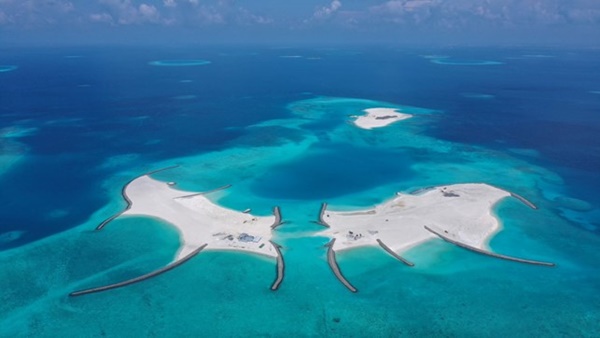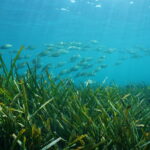Aiming for a 70% reduction in CO2 emissions in 2030 – largely by promoting more renewable energy – the Danish Parliament adopted a climate agreement in June 2020 enabling Denmark to become the first country in the world to build an artificial energy island.
The first-of-its-kind energy island will be situated approximately 100 km offshore in the North Sea where the initial plan is to harvest 3 GW power (expanded in phases to 10 GW) from surrounding wind farms. The island will serve as a hub to facilitate power transmission, accommodate power storage and transform electricity into new forms of energy (Power-to-X).
Construction of the artificial energy island is a massive investment and reducing risks to a minimum is crucial for such a large-scale critical infrastructure. In a bid to play safe, all conceptional designs of the island have so far been based on the use of hard structures such as breakwaters, rock revetments and concrete caissons. However, it is a common misconception that coastal protection can only be achieved with hard structures.
Real-world experiences have revealed that even at exposed sites, natural beaches, and soft engineering approaches such as beach nourishment, work best to protect coastlines against wave attack.
Dr. Nicholas Grunnet, Head of the Coastal Engineering Department at DHI, answers our questions about the use of soft engineering as an effective coastal protection strategy. Read on to learn how recent innovation in computational coastal engineering are allowing design professionals to smartly use sand as a form of sustainable coastal protection.
Q1: What are the challenges in constructing energy islands?
Energy islands are conceived where steady and strong wind conditions are prevailing, which typically means in the open sea. This entails higher wave conditions and deeper water, both of which challenge the constructability with very short weather windows allowing safe working conditions. Another related challenge is the logistics of transporting the required building materials far out to the open sea. This naturally raises the question of, ‘Why not use sand?’, since it is typically an abundant seabed material in the immediate vicinity.
Q2: Can you tell us more about ‘soft engineering’?
In coastal management, soft engineering is about working with nature to protect the coast. This reduces negative impact on the environment and creates more sustainable solutions as compared to hard engineering projects, such as building sea walls, groynes and other structures.
At DHI, we regard waves as external opportunities rather than perceive them as problem generators which we need protection from. We accept that natural forces are continuously reshaping the coastlines. The art of using sand as coastal protection is designing a beach close to its equilibrium shape. Lateral support structures are often necessary to sustain stable beaches and required in the case of a 360o island. DHI has already designed a conceptual energy island to fit the needs of the proposed energy island in the North Sea. Although a truly sand-engineered solution, the optimisation has led to the installation of a few fish tail groynes around the perimeter to stabilise the sand.

Q3: Will an energy island enhance local biodiversity?
Any artificial island would potentially change the seabed from a homogeneous ‘desert’ to a new local biodiverse ‘oasis’. While vertical walls only favour a few species like marine mussels, stones as part of groynes and breakwaters will act as local stone reefs at shallower depths (0-10m) allowing ecosystem enhancing designs. Stone cover in deeper depths (>10m) will act as local stone reefs, creating potential habitats for fish like cod, lobsters and macro algae. Sand beaches will act as potential resting spots for e.g., seals.
Q4: Why are soft engineering methods not considered for the Danish energy island?
For decades, hard structures have become a comfortable commodity in coastal infrastructure solutions. Offshore conditions at the planned North Sea site at a depth of 25-30 m are extreme and it can be argued that design significant wave heights on the order of 12 m may be pushing it too far for a sand-based coastal protection for this pioneering energy island.
In addition, this extreme wave climate may lead to loss of sand during stormy events. Although we can take steps to reduce sand loss, or design preventive nourishment maintenance schemes to account for a sacrificial buffer on the dry beaches, sediments are moveable by nature – and hence the coastline will remain dynamic during stormy events. I have to admit that it may be hard for asset owners to conceive that the level of coastal protection may change in time. However, this threat can be properly managed, and we have completed many successful projects that have solved this challenge.
Q5: Is there a global application of this sand-based approach?
DHI has an extensive track record in the art of designing recreative islands across the oceans, e.g., for tourism development projects where attractive and stable beaches are a prerequisite for the business. Our most recently designed islands are under construction in the middle of the Indian Ocean (see illustration) also exposed by extreme waves, but at more shallow water depths compared to the North Sea. Offshore wind energy is a fast-emerging business in the APAC region, where countries like South Korea, Taiwan, Vietnam, Japan, China, and India have set ambitious targets. South China Sea and Yellow Sea would likely be ideal candidates for any organisation wanting to venture into sand-based energy islands.

Q6: Does DHI have reliable tools to design energy islands protected by sand?
Artificial islands and beaches don’t know they are manmade, so they will react to the impacts of nature in the same way as natural beaches. It is therefore important to understand the mechanisms that generate natural and resilient beaches. DHI makes decisions concerning shoreline management based on a deep understanding of complex natural processes. The latest scientific and technological advances are captured by our detailed coastal models. It is precisely this combination of deep knowledge and models that provide trust in modern coastal engineering tools for decision-making.
Q7: What kind of future possibilities do you think this digital age will bring to coastal resilience planning?
We can certainly achieve more with soft engineering. It’s in the combination of the site-specific coastal processes and the naturally present plant and animal species that future coastal protection should be designed. Numerical models play a large role here in opening doors of opportunity for innovative coastal protection schemes in interaction with ecosystems. Why not envisage dynamic protection with gravel structures e.g., underwater reefs to promote protection and biodiversity or even as beach nourishment material? It has a merit that needs to be unveiled – our new multifractional sediment transport models are a first step in exploring this direction. Nature-based coastal protection with lesser impact on the environment is the way forward and we are ready to embark on this journey.
Take a look at wave models built in MIKE 21 Boussinesq Waves for DHI’s most recently designed islands in the middle of the Indian Ocean:








